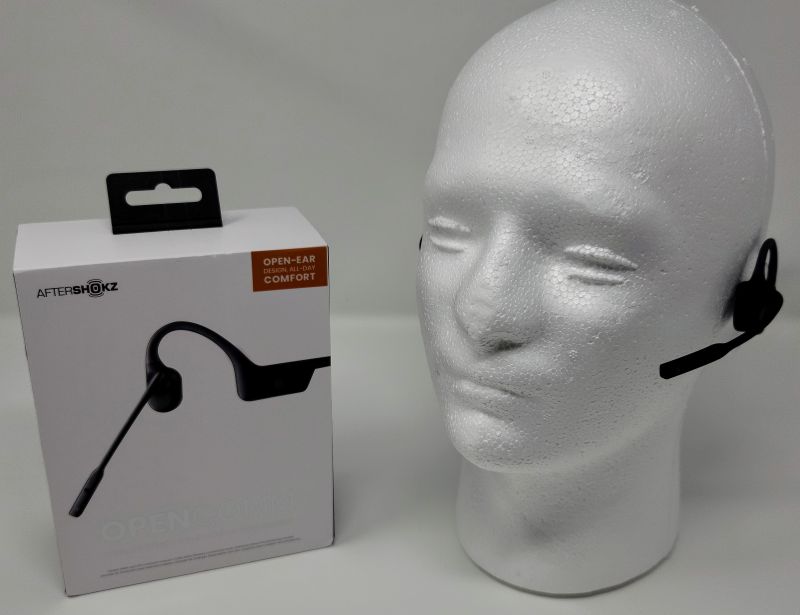
REVIEW – Thanks to a virus (and shades of 2020) I lost a lot of my hearing on one side. Headphones and earbuds don’t provide much help for this condition – in order to get something akin to a stereo experience I have to crank the balance way over to the side and turn the volume up. A bone conduction headset seems like it would be a great solution, at least for the inevitable deluge of conference calls that this year has become. So, with great hope, I plunge into the bone conduction world with the AfterShokz OpenComm headset…
What is it?
Bone conduction audio delivers sound via vibrations applied to your cheekbones where it is picked up by your inner ear. The technology has been around since the 1950’s and is often used to treat some types of hearing loss. The AfterShokz OpenComm is a bone conduction headset specifically designed for communications via softphones or real phones, conference software or other communications mediums. By delivering the audio via bone conduction, your ears are freed to hear what is going on around you – in other words, it promotes situational awareness without impeding communication.
What’s in the box?
- The AfterShokz OpenComm headset
- A proprietary charging cable
- A hardshell case
- All the usual paperwork
How does it work?
The OpenComm comes with a proprietary charging cable. Under normal circumstances, I would take a point away, but this headset uses a special (and powerful) magnetic connection that doesn’t require peeling open a rubber port cover and trying to wedge a micro-USB connection into the port. Super simple, quick and efficient, so add one point here. The picture below gives you an idea of how the charger connects to the headset.
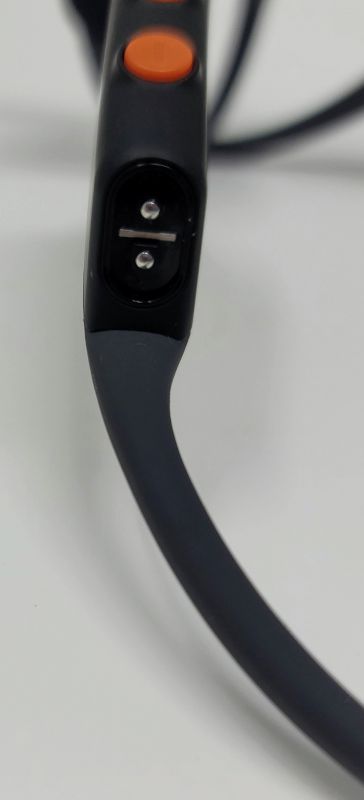
After a couple of hours to charge I am ready to connect the headset to my computer and my phone. One thing to note – it does not appear that the OpenComm has multipoint technology, so it can be connected to only one device at a time. Pairing is a breeze, though – standard Bluetooth device discovery on my computer and NFC tap and connect on my phone. I was up and running on both in a matter of minutes.
The mic on the OpenComm is on the left side, which is an unusual configuration for headsets with boom mics. The mic can swivel back and out of the way if you are listening to music, but moving the mic does not mute it as other headsets do. Other than the mic and the conduction pad, there is nothing else on the left.
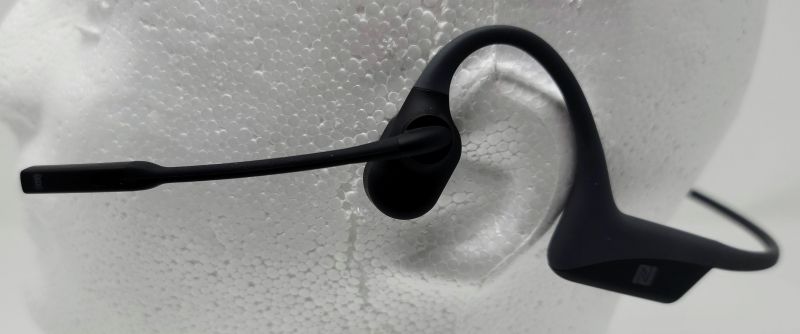
The right side is where all the action takes place. The charging port, volume up and down (separate buttons – yay!) and the multifunction button are all here. That’s the multifunction button on the conduction pad, and the volume controls are on the underside – a better picture of that in a second.
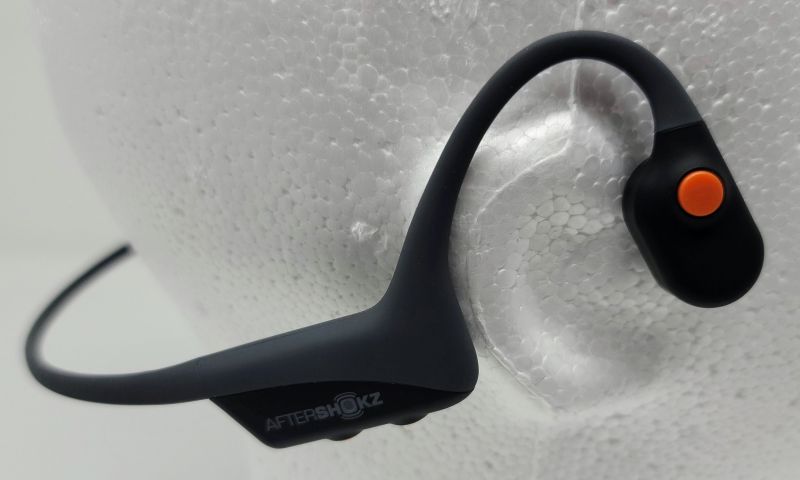
The volume up and down buttons. Pressing and holding the volume up turns the headset on or off. Pressing both for two seconds will mute/unmute the mic when on a call.
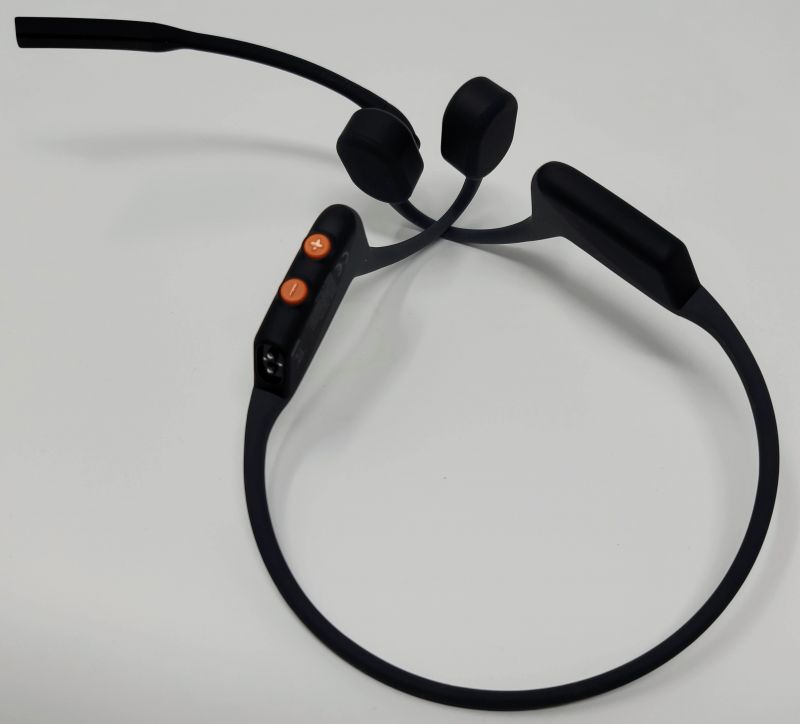
A little more on the mic: there are additional mic pickups (one of which is visible in the shot below) which provides outside noise cancellation for the mic. It is able to isolate your voice from the background and deliver crisp, clear sound.
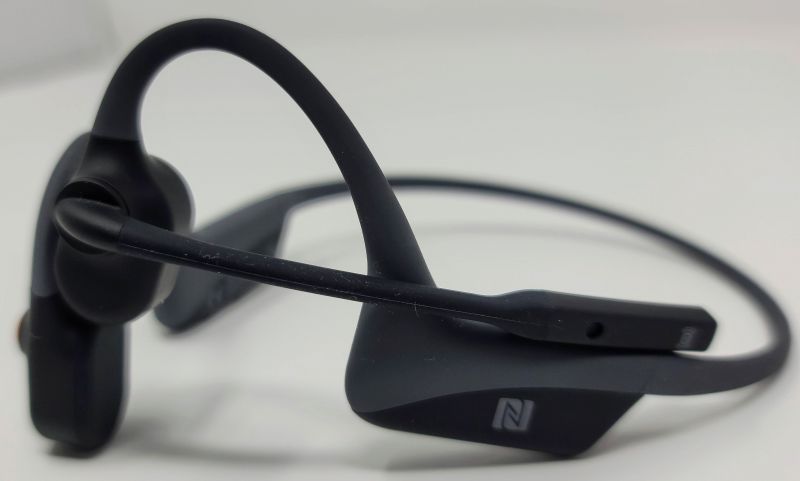
And when you aren’t using the headset, AfterShokz includes a nice hardshell case to store the headset and related stuff.
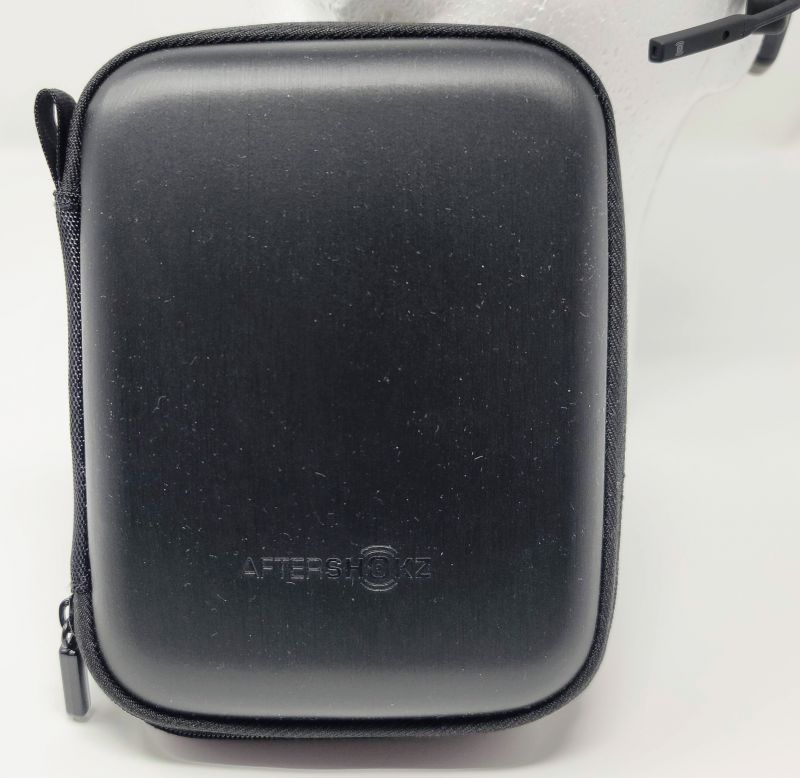
So now, the real question: does it work? And the answer is a resounding yes. For the first time in a great many years, I can clearly hear Zoom/Teams meetings, phone calls, podcasts and more. It feels like there is a touch more base in bone conduction than there is in a traditional set of headphones – likely because sound waves are not really a part of the picture anymore with this technology. It is also the reason why your voice sounds different in your head when compared to listening to a recording of yourself.
In every single meeting and call I have been in I get kudos for being able to be heard clearly. Hands-down this is the best mic on any headset I have ever had – much better even than the very expensive Universal Communications headset I own from another company, a device that cost just slightly over double what this headset runs. Let me paint a little picture of how good this mic is – on a call last week, the UPS guy rang my doorbell and my Google Assistant next to my desk chimed in to tell me someone was at the door. My two dogs laying about 3 feet away went into the usual frenzy when the doorbell rings (because it could be someone coming to play with them or it could be one of the neighborhood squirrels messing with them), running to the front door barking all the way. No one in my meeting was even aware this happened. I was, they weren’t.
Situational awareness is an important thing, and keeping your ears free while being able to participate in a call or listen to music can be very important. This is especially true if you have a job like a delivery driver – you need to be able to hear what is going on around you and sidetone (the compensation technology used by most other headsets to allow some background sound in) just isn’t all that effective, even if your hearing is 100%.
As far as comfort goes, the OpenComm is right at the top of the list. In the 3 plus weeks I have been using the headset I tend to wear it 8-9 hours a day. There are more than a few days every week where I forget to take the headset off when I leave my office because I forget I am wearing it. But if a call comes in or a team member reaches out during office hours, I can respond quickly. And there isn’t the heat and ear pain associated with traditional on or over the ear headsets, so this really is an all-day device.
The sound quality for music, though, is good but stops just short of great. There is a distinct lack of high notes, and that is directly attributable to bone conduction. It is more than adequate for work use if you need to be aware of what’s going on around you, but you don’t buy the OpenComm for the audiophile experience. And it really shines on podcasts or other human voice-driven entertainment like standup comedy.
What I like
- I can finally “hear” clearly on conference calls (and my team members don’t have to put up with multiple “can you say that again?” questions)
- Proprietary but markedly better charging than similar headsets
- And everyone can hear me clearly regardless of whether I am in a coffee shop or in close proximity to two fearless squirrel fighters
What I’d change
- Make swiveling the mic out of the way also mute the mic
Final thoughts
In a year that has fundamentally changed how and where I work, I have been looking for the right tech that will help me power through the changes. I am really sorry that the AfterShokz OpenComm was released only a short time ago. The headset has almost instantly become my favorite communications device, and selfishly I wish I had this device back when all the craziness started. Sure, there are some quirks – crank the volume all the way up and feel the buzzing on your cheek. Even with my hearing loss, I find I never need to go that loud, but it is good to know. The comfort and clarity the OpenComm brings to my day greatly outweigh literally any perceived quirks. If 2020 has turned you into a Zoom warrior, the AfterShokz OpenComm needs to be on your head.
Price: $159.95
Where to buy: At the AfterShokz store or on Amazon
Source: The review headset was provided by AfterShokz. Visit their web site for further information.



Gadgeteer Comment Policy - Please read before commenting
Check out link below to setup multipoint. I got these in October and have them paired to a phone and laptop.
https://us.aftershokz.com/blogs/news/how-to-set-up-multipoint-pairing-aftershokz?gclid=Cj0KCQiA0MD_BRCTARIsADXoopaUyUSoKV55wkDEPTjVtCwrHVXHx7WB_KzJZkXN22cI_QGtLK-PGM0aAq8WEALw_wcB
I’ve been using the OpenComm for the past couple of months. My manager as well. I’ve also gotten a few other people using them. Once you get past the “my head is vibrating feel” that sometimes happens, it’s probably one of the best headsets I’ve used for my continuous days of Zoom calls.
I also picked up the Aeropex from AfterShokz that I now wear when walking and biking. Sound quality isn’t as good for music, but spoken word like podcasts it’s great to have my ears not blocked.
The OpenComm does support multipoint connectivity. The instructions are available on AfterShokz’s website. They’re a little convoluted, but they work. I’m not sure why they didn’t include this in the instruction manual.
https://help.aftershokz.com/hc/en-us/articles/360053359094-Commands-OpenComm#How%20do%20I%20set%20up%20multipoint%20pairing?
I can sit next to a wall unit air conditioner in my plexiglass enclosed 8’x8′ pergola and NO ONE hears it and it runs continuously in 96 degree heat! Awesome and clear for everyone I call. Better than Bose 700 for $350 and Steelseries Arctic Pro for $350 AND Way more comfortable than the BLUE PARROT Truckers series of headsets – just as effective AND it wont slip off your neck and get lost when taking it off your head!!! What a great design!!
Bummer about no multipoint. My Aftershokz Aeroplex has multipoint.
Thanks for all the notes with the link to enabling multipoint. I followed those instructions and multipoint is enabled, but it just doesn’t work as you would expect. Both my laptop and my phone say I am connected simultaneously. Whichever device is first to serve up audio seems to be the active device (as expected), but when an event on the other device occurs, the headset doesn’t want to change. For example, I am listening to a podcast on my laptop and the phone rings. My expectation is that I could answer the phone and the podcast would be paused. For me, the headset does not even register the incoming call. I pause the podcast and manually answer the phone, and the phone shows I am connected to the headset, but no audio.
I don’t know if there is a firmware update. Either way, I’ll contact customer service. These have the potential to be a great headset, so I can live with a few quirks should it come to that.
Great review, thanks.
For me the only issue is the lack of on set controls for when 8 use it on my Windows laptop with Microsoft Teams. I can’t mute the mic, I can’t control the volume, I can’t do anything using the buttons on my headset. If I want to stretch my legs in a conference, I have no controls, i need to get back to the laptop to mute/unmute the microphone.
Hello, I received the product last week and I can’t make it work properly. I work by phone via my laptop, normally I use wired headphones and it works without problem. With your product I succeeded to connect it with my windows laptop but I can’t answer the phone with the orange button, I push on it, it makes a sound but doesn’t take the call.. I have to answer with my mouse on the computer. Can you help me?
Tks
Gael
As this isn’t our product, your first, best resource would be AfterShokz’s tech support.
That said, the first question to ask yourself is whether this is a real phone or a soft phone on the computer. If it is a real phone, then the headset should be connected to the phone, not the computer. If it is a soft phone (phone software like Slack or Teams or similar), the headset should be compatible. I use mine with Teams and when I get a call, the multi-function button answers without a problem. It may be that whatever soft phone you are using is not compatible. This was a common problem for years, but in the age of coronavirus most soft phone vendors have made their apps compatible with the prevailing standards – to be fair, most have actually done this before the last year, but there are still hold outs.
So I would contact AfterShokz and see if your soft phone is compatible or if there is another option…
Tks David!
When using Teams the volume controls on the headset do nothing. I’d be curious to know if you have the same issue and if not you may to contact AfterShokz and let them know your settings. I was in a chat with them earlier today trying to resolve with no luck so far.
I have used these with Teams both on my PC and on my Android tablet. On the tablet they work great. On the PC, not so much. As you said, the volume controls do nothing. I also have problems with the mic going mute by itself – but this only started with an update to Teams on the PC a little over a week ago. The problem has become so bad I can’t use them reliably anymore – a shame, because I really love these.
There’s a concession in questions about this on Amazon – on January 15 someone from AfterShokz noted that the volume control and mute function will not work with either Teams or Zoom. So I guess that’s the definitive answer, but not the one I want.
The muting feature is a big issue. It will beep about very 20 seconds. Not a soft beep but very loud and distracting. On Zoom and team calls it is impossible to concentrate. Loved everything else about them. This made it a no go for me. I called support and they said they knew about the issue but could no offer any advice. That is just how they work.
Could you more explain?
In which situation does it beep?
Actually I want to use it for my Zoom class 3 hours a day everyday.
Please help me to decide.
When you put it on mute. The beep is to remind you that you are on mute. It beeps very 10 to 20 seconds. It is loud and distracting. No matter if you use Zoom mute or the laptop mute the beep is still there. No way to adjust the beep volume. Spent several hours with tech support but could not resolve.
My understanding is that their engineering team is working on it but not ready. It is too bad because they are great head phones otherwise.
I experience the same problem. My understanding is, that the developers are working on a dongle or something. The headset is somehow useless as of now. sadly.
hahaha, yeah I am experiencing the same thing. Very irritating. They should have an option to allow users to remove the beeping sound. I do not need to be reminded that I am muted…. and the beeping sound is every 10 seconds! and it is so loud.. :p Somehow in zoom conference call, I did not experience the beeping sound.
Otherwise, the headset is awesome.
I wonder if anyone managed to solve the beeping sound issue when muted on MS Teams.
I bought my headset last month and this happens and it is very annoying.
We got another headset for my colleague and this doesn’t happen. I wonder if they updated the new model not to have this annoying functionality any more.
“What I’d change: Make swiveling the mic out of the way also mute the mic” Yes! Completely agree it is eagerly to have.